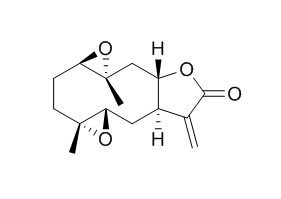11(13)-Dehydroivaxillin
11(13)-Dehydroivaxillin possesses a promising antiplasmodial activity, which can be exploited in malaria therapy.
Inquire / Order:
manager@chemfaces.com
Technical Inquiries:
service@chemfaces.com
Tel:
+86-27-84237783
Fax:
+86-27-84254680
Address:
1 Building, No. 83, CheCheng Rd., Wuhan Economic and Technological Development Zone, Wuhan, Hubei 430056, PRC
Providing storage is as stated on the product vial and the vial is kept tightly sealed, the product can be stored for up to
24 months(2-8C).
Wherever possible, you should prepare and use solutions on the same day. However, if you need to make up stock solutions in advance, we recommend that you store the solution as aliquots in tightly sealed vials at -20C. Generally, these will be useable for up to two weeks. Before use, and prior to opening the vial we recommend that you allow your product to equilibrate to room temperature for at least 1 hour.
Need more advice on solubility, usage and handling? Please email to: service@chemfaces.com
The packaging of the product may have turned upside down during transportation, resulting in the natural compounds adhering to the neck or cap of the vial. take the vial out of its packaging and gently shake to let the compounds fall to the bottom of the vial. for liquid products, centrifuge at 200-500 RPM to gather the liquid at the bottom of the vial. try to avoid loss or contamination during handling.
Pharmacogn Mag.2015, 11(43):562-6
Int J Mol Sci.2021, 22(21):11447.
Biol Pharm Bull.2018, 41(11):1645-1651
Acta Edulis Fungi2020, 27(02):63-76.
Clin Exp Pharmacol Physiol.2015, 42(11):1189-97
Int Immunopharmacol.2024, 141:112906.
Molecules2022, 27(9):2992.
Life (Basel).2023, 13(2):457.
Biomedicines.2021, 9(8):996.
Int J Mol Sci.2020, 21(9):3392.
Related and Featured Products
J Enzyme Inhib Med Chem. 2009 Feb;24(1):247-50.
In vivo antiplasmodial activity of 11(13)-dehydroivaxillin from Carpesium ceruum.[Pubmed:
18608780]
The whole plants of Carpesium genus are used in traditional medicine as anti-pyretic, analgesic and vermifugic, including a topical application for sores and inflammation. A previous study on Carpesium genus suggested that the antiplasmodial activity against Plasmodium falciparum was due to the existence of 11(13)-Dehydroivaxillin (DDV) from EtOAc extracts of C. ceruum (Compositae).
METHODS AND RESULTS:
Here, the antimalarial activity of 11(13)-Dehydroivaxillin was evaluated against Plasmodium berghei in mice. The LD(50) of the compound was determined as 51.2 mg/kg, while doses of 124 mg/kg and above were found to be lethal to mice. 11(13)-Dehydroivaxillin (2, 5, 10 mg/kg/day) exhibited a significant blood schizontocidal activity in 4-day early infection, repository evaluation and in an established infection with a significant mean survival time comparable to that of the standard drug, chloroquine, 5 mg/kg/day.
CONCLUSIONS:
11(13)-Dehydroivaxillin possesses a promising antiplasmodial activity, which can be exploited in malaria therapy.



